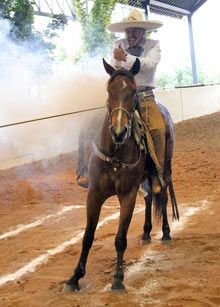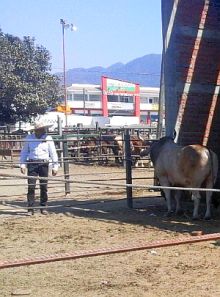Puerto Vallarta, Jalisco, Mexico - Living with a Mexican host family is very helpful for a journalist as he has access to lots of inside knowledge. The 14th National Charro Championships, held March 3-6 in Puerto Vallarta, was hardly an insider event, but when you are young and very far away from home and you are just starting out as a writer it is nice to have someone as a guide in this brilliant and crazy country.
On saying the Charrerķa is not an insider event, there didn't seem to be any Americans or Canadians there; and it was comforting to have my host brother Jorge amongst the many cowboy-looking Mexicans. When it did come down to knowledge though, Jorge was nearly as clueless as I was, because this was his first Charro too.
"It's like a rodeo," Jorge said.
"I don't know anything about rodeos," I replied.
"I forget you are British," he said. "We will have to watch very carefully then, so we can understand and you can write well."
"Right," I said, and took out my notebook.
In front of us there was a large sand-filled arena and lane. Along the lane came mounted cowboys. When they entered the arena they pulled hard on the reins and the horses, locking their legs so that they skidded and sprayed sand, looked like some sort of wheeled animal. After a while the cowboys gathered at the bottom of the lane. Some of them made their horses dance to the live Mariachi band, consisting of drums, horns, guitars and singers. The horses made prancing steps with their feet.
 |
Then the crescendo broke and out of a gate flew a bewildered-looking horse that whipped along the length of the lane and the cowboy, swirling, fired his lasso at the horse that started to buck wildly with the lasso drawn tightly on his hind legs. He bucked high in the air so that his whole body, right down from his neck, seemed to stretch and pull against the rope. Bucking and bucking he bucked himself free.
Jorge and I looked at each other with our mouths gaping. He claims that he isn't a typical Mexican and doesn't like that many Mexican things. Whereas the Mexicans around the arena were clapping and seemingly invigorated, Jorge said, "I don't like to see the animals stressed like that."
"Neither do I," I said. But when another horse went rushing down the lane I couldn't take my eyes away. Nor for the next one, nor the one after that. There is a terrible moment when the horse realizes he is snared; when, on his first resistance against the pull of the rope, his eyes go wide and he becomes sort of suspended in the air. Then he will come down hard and start in with his wild bucking like a bronco.
Jorge suddenly said, "I will help you," and spoke to a Mexican behind us.
After some rapid Spanish he turned back. "This is called Piales en Lienzo. You get points for the distance needed stop the horse." He pointed out some red number markings on a wall: 60, 50, 40, 30, 20, 10.
This Piales en Lienzo (roping of the feet) went on for quite a while and many horses were caught with the cowboy's lasso. Always, with a lot of bucking, the horse broke free. Sometimes the lasso missed. Not a single horse fell down.
The band then played some rising tune again. It went on rising, very loud, and blew up when a bull tore out from a gate. A cowboy took chase, reaching out from the back of his horse and trying to get a hold of the bull's tail. The cowboy leaned back with the tail in his hand and then, with an arcing drag, the bull smacked down onto the sand. He got up quickly, stunned and dusty, and trotted off like the horses did.
Jorge had been talking with the Mexican man again: "This is called Colas en el Lienzo. You have to bring the bull down by his tail; and it is the same with the points and distance, but also you have points for technique."
One of the biggest of the running bulls went down hard. He was conscious but refused to get back up. A man was kicking him. Eventually they brought out a white pole that you can only imagine was electric, and he got up after a couple of prods. The next problem, though, was that he turned back on himself and worked into the crowd of cowboys. Although he seemed more dumbfounded than angry, the cowboys were quick to get out of his way. He dogged around for a little while, not really charging for anyone, until two riders lassoed him by the neck and dragged him out.
 |
First they seemed to tire the bull by running him down. Then they lassoed him. It looked as if they drew the rope very tight, because his once muscular neck was now thin and constricted. As they dragged him around the arena his tongue hung out and long drools of saliva dripped from his mouth. A number of times he stopped and refused to move, but tightening the rope saw to that. It seemed to have already gone on longer than ten minutes when the second cowboy lassoed the back legs. Each cowboy then pulled and the bull went down. His tongue lay out on the sand.
This went on, but our attention was on something else now - a monstrous bull, surely a thousands pounds, being led toward the arena. He was a sort of milky color, with dark eyes and devilish horns, and his muscular body rippled as he walked. Looking around it was clear that everyone had their eyes on this brute. Then he disappeared into a covered pen, as the tension rose again with the music.
You could see the door bulging and rattling. The cowboys, crowded over the pen, seemed to be doing something - lowering another cowboy inside. A second later he burst out of the door riding the bull. The bull could buck quite spectacularly for such a large animal; and his mad bucking made the cowboy on top look like a rag doll. The cowboy held on with only one hand; the other he had out to the side flailing around. This arm was crushed when the bull toppled over. A crowd of cowboys rushed over and used their sombreros as fans. They had to take that cowboy away on a stretcher.
Another bull was in the pen already, though Jorge and I decided that we had seen enough.
'You have enough to write a good article?' Jorge asked.
'Maybe,' I said.
Before we left we had a look in the market that wound around the arena. At the end of the market was a pen of bulls. The bulls looked very docile, standing calmly in the shade. Sean Harris was born in Bristol, England, and studied Creative Writing at Bath Spa University. Straight after his graduation he went to Virginia, USA, to work as a boat captain. Since then he has been traveling and writing about his experiences. Apart from reading and writing he likes fishing, football and playing chess. Currently he is getting journalism experience with BanderasNews.com in Puerto Vallarta through Global Volunteer Projects. When he goes home he will look for work on a newspaper or go to Africa. His dream is to be a novelist.
Sean Harris was born in Bristol, England, and studied Creative Writing at Bath Spa University. Straight after his graduation he went to Virginia, USA, to work as a boat captain. Since then he has been traveling and writing about his experiences. Apart from reading and writing he likes fishing, football and playing chess. Currently he is getting journalism experience with BanderasNews.com in Puerto Vallarta through Global Volunteer Projects. When he goes home he will look for work on a newspaper or go to Africa. His dream is to be a novelist.


